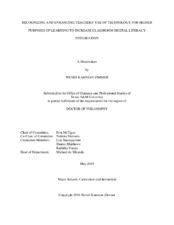| dc.description.abstract | In this study, I hypothesize that various factors impact teachers’ digital learning identity
(DLI). Such factors include; (1) instruction, (2) experience, and/or (3) application. As learning
identity relates to perception of confidence and ability, a possible link exists between teachers’
DLI (i.e., how they use technology for higher purposes of learning) and the low percentage of
teachers using digital literacy (DL) successfully for instruction. To test this hypothesis, I created
the Digital Learning Identity Survey (DLIS) to determine how teachers’ affect toward digital
learning changes with direct instruction in DL and what causes these changes. The DLIS results
serve as a baseline for a coaching model of professional development aimed at assisting teachers
in better recognizing their DLI and the influence the coaching model has on such recognition as
well as which aspects of coaching were most influential. Using a mixed-methods approach, 11
K-12 teachers in the southwestern United States completed artifacts (e.g., weekly check-ins, goal
setting, reflections, and emails) to determine the influence of the coaching model. Additionally,
five of the 11 teachers participated in three rounds of semi-structured interviews to determine
teachers’ motivation to shift their DLI.
Using artifact analysis and DLIS results, I drew three major conclusions: (1) these studies
demonstrate that by helping teachers recognize their own DLI, we can increase their DL use,
moving teachers from solely focusing on their students’ DL use to their use; (2) supporting
teachers’ ability to recognize the ways they can use DL for learning instead of learning to use DL
tools may help further develop their DLI, and such recognition is best suited for coaching-based
PD; and (3) the literacy research field requires both measures and methods for integrating DL in
classrooms, and the DLIS measures aspects of DL, motivation to learn, and self-regulated
learning, producing reasonably reliable and valid scores for DLI.
Teachers’ interviews indicated various motivations influence a shift in DLI. Overall,
linked to Expectancy-Value Theory, teachers showed evidence of motivation linked to
individualized coaching based on opportunities to reflect on the influence of their background
and experiences on the value they associate with DL and expectancy of success. Reflection
enhances realization of background influences, elements of support, and opportunity to learn. | en |


